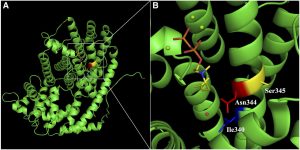Cineole Synthesis in Kiwifruit
Over 80 volatile organic compounds (VOCs) have been described in ripe kiwifruit (Actinidia spp.), with the most important odor-active  compounds typically being straight-chain esters and C6 aldehydes and alcohols. Another odorant proposed to be important in the flavor of ‘Hort16A’, one of three major cultivars of kiwifruit, is the terpene 1,8-cineole. Terpene volatiles are found in many important fruit crops but their relationship to flavor is poorly understood. By means of sensory descriptive and discriminant analysis, Zeng et al. (10.1104/pp.20.00186) demonstrate that the monoterpene 1,8-cineole contributes a eucalyptus-like note to the aroma of ripe ‘Hort16A’ kiwifruit. The final step in terpene biosynthesis is catalyzed by the terpene synthase (TPS) enzyme family. A number of TPS genes have been shown to be responsible for VOC production in different kiwifruit tissues and developmental stages. However, definitive genetic and biochemical evidence for signature flavor production in kiwifruit cultivars has not been reported. In the present study, the authors report that the transient over-expression of AcTPS1b in A. eriantha fruit confirmed that the enzyme encoded by this gene plays a major role in 1,8-cineole production in Actinidia. Their results also highlight the complexity of terpene production in kiwifruit with multiple TPS genes from a single locus producing different terpene products in different tissues and at different times. This diversity can potentially be utilized in breeding novel flavored kiwifruit, and in understanding the structure-function relationships between different TPS enzymes.
compounds typically being straight-chain esters and C6 aldehydes and alcohols. Another odorant proposed to be important in the flavor of ‘Hort16A’, one of three major cultivars of kiwifruit, is the terpene 1,8-cineole. Terpene volatiles are found in many important fruit crops but their relationship to flavor is poorly understood. By means of sensory descriptive and discriminant analysis, Zeng et al. (10.1104/pp.20.00186) demonstrate that the monoterpene 1,8-cineole contributes a eucalyptus-like note to the aroma of ripe ‘Hort16A’ kiwifruit. The final step in terpene biosynthesis is catalyzed by the terpene synthase (TPS) enzyme family. A number of TPS genes have been shown to be responsible for VOC production in different kiwifruit tissues and developmental stages. However, definitive genetic and biochemical evidence for signature flavor production in kiwifruit cultivars has not been reported. In the present study, the authors report that the transient over-expression of AcTPS1b in A. eriantha fruit confirmed that the enzyme encoded by this gene plays a major role in 1,8-cineole production in Actinidia. Their results also highlight the complexity of terpene production in kiwifruit with multiple TPS genes from a single locus producing different terpene products in different tissues and at different times. This diversity can potentially be utilized in breeding novel flavored kiwifruit, and in understanding the structure-function relationships between different TPS enzymes.



